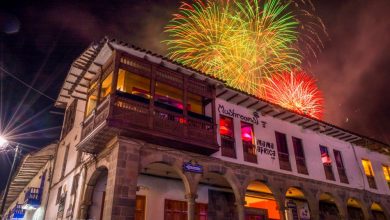Aguaje Fruit Pleases and Delights in Cusco

An exotic fruit that is typical of South and Central American, the aguaje is claiming ever more interest among cooks who seek new sensations for the palate. In the Peruvian jungle one can find many dishes, drinks, ice creams, sweets, and desserts based on aguaje. Now it is easy to find aguaje recipes online, such as causa de aguaje. Stuffed aguaje, aguaje cocktails, cakes and many more.
In Cusco, this fruit lets off a new perfume that entices passersby who do not know it. It used to be that it was only rarely found in our popular markets.
By the bus stops found on Santa Clara Street, some 50 to 60 steps away from the San Pedro market, you will find a casera, vendor, named Giuliana. She sells aguaje fruit and aguaje drink. The glass of refresco, the drink, costs 1 / S and the disposable bottle runs 3 / S. The fruit is sold at five for 1.5 / S.
When I saw the fruit’s wine red color on top of one of the buckets of refresco that Giuliana had it awakened in me the desire to be in the jungle and exposed to the heat. In Puerto Maldonado, a nearby jungle city and capital of the Madre de Dios Department, there are a variety of iced refrescos, drinks, to combat the heat. These include camu camu fruit, barley water, cocona fruit, and corn chicha, but the star is without any doubt the aguajina, as it is called, the water made from aguaje.
In this way people consume aguaje because of its high content of minerals, vitamins, proteins, and antioxidants. Women especially like to drink this refreshing beverage since it equilibrates their hormonal levels and makes them look more charming and beautiful. They say the drink is also good to help when a woman reaches the age of menopause.


When I arrived at the stand of casera Guiliana, she was helping other clients. I aksed for a glass of the aguajina refresco and she served me from one of her 10 liter buckets a glass of this yellow and almost orange drink that I like a lot and that I missed from my days in the jungle. With the first sip I sensed a light, sweet taste. It was not heavy. I really liked it and asked her how she made it. With a smile on her lips she said, “You have to first let aguaje fruit sit in warm water so that its peel gets soft and easy to peel. After peeling it you take the yellow pulp and put it into a receptacle with boiled but cold water. You then put it in the blender and blend it. You sieve it to take out the big pieces and then you add it to a pitcher. You add sugar to taste and, if you wish, you can add ice just like in the jungle.”
“Ummm,” I said, “are you from the jungle?”
“Yes. From Madre de Dios. I have been in Cusco for three months.”
I asked her where she gets the aguaje fruit to sell and make her refresco. She said, “I live here in the house of a woman from Puerto Maldonado who has her aguajal, aguaje planting. She sends me fruit to sell three times a week.”
“How many buckets of aguaje do you sell each day,” I asked her.
“If I go out at 9 am, by noon I will have sold two buckets worth of aguajina but I continue to sell fruit until 2 pm. Then I go home to take care of my children.”
I asked her for five aguaje fruits and said goodbye and thanked her.
When I got home I could not wait to try the fruit. I left it to sit in a receptacle with hot water so that it would be easy to peel and when it was all peeled I placed it on a flat plate.
A memory came to mind. The first time I tried this fruit was in the jungle of Pucallpa, Peru. There on every street in the afternoon, wherever I roamed, people offered me the fruit or a glass of aguajina. I bought a bag of peeled aguaje and the first bit of fruit I tasted struck me as a bit bitter. For my palate it was something new. It was neither sweet nor salty. After eating two or three it conquered my taste buds. It became an addiction. Every day I had to eat at least one aguaje with a bit of salt like they eat them there.

In Pucallpa I also learned that the pure oil from the aguaje fruit, which grows on a palm tree, is good for scars, burns, and wounds since it promotes the regrowth of body tissues. Artisans also use the fruit’s seeds to make pipes, carvings, incense burners, key rings, and so on. The seed is soft when fresh but when it hardens it grows very hard and strong like a stone carved by the river. The leaves of the aguaje palm are used to thatch roofs of houses, to make baskets, and from the trunk of the palm they make homes, boats, walls, and floors.
This is one of the most representative fruits of the Peruvian jungle. The palm tree grows on the banks of rivers. The fruit is eaten every day to avoid dry skin, rehydrate it, and now in Cusco it is eaten more and more each day. With time it will become a well-known alternative.




